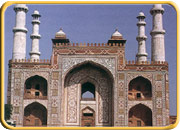Agra
Agra Excursions
Sikandra Fort
 A
visit to Akbar's monument opens before one, the completeness of Akbar's personality
as completely as the Taj Mahal does of Mumtaz Mahal's. Akbar's vast, beautifully
carved, red-ochre sandstone tomb is set amidst a lush garden. Akbar himself
planned his own tomb and selected a suitable site for it. To construct a tomb
in one's lifetime was a Tartary custom which the Mughals followed religiously.
Akbar's son Jahangir completed the construction of this pyramidal tomb in 1613.
A
visit to Akbar's monument opens before one, the completeness of Akbar's personality
as completely as the Taj Mahal does of Mumtaz Mahal's. Akbar's vast, beautifully
carved, red-ochre sandstone tomb is set amidst a lush garden. Akbar himself
planned his own tomb and selected a suitable site for it. To construct a tomb
in one's lifetime was a Tartary custom which the Mughals followed religiously.
Akbar's son Jahangir completed the construction of this pyramidal tomb in 1613.APPROACH:
One can approach the monument from the Southern gate only. Ticket counter is located to the left of this gate. THE GARDEN:
The tomb stands in the center of a vast garden, which is enclosed by high walls on all sides. In the middles of each enclosing wall is a monumental gateway. The whole garden is divided into four equal quarters on the conventional charbhag plan. Each quarter is separated by a high terrace or raised path with a narrow shallow water channel running at the center. Each terrace has in the center, a tank with fountains.
GATEWAY:
Although there is only one entrance in use today there exist four red sandstone gates which lead to the mausoleum complex. The decoration on the gateways is strikingly bold, with large mosaic patterns set into it. The gateway's four minarets rising from the corners are particularly striking. Built of red sandstone, the minarets are inlaid with white marble polygonal patterns; the pleasing Proportions & Profuse surface ornamentation makes the gateways very impressive. These gateways reflect a curious hybrid of different styles of architecture-Hindu, Muslim Christian and a patent mixture of Akbar's typical style.
MAUSOLEUM:
A broad paved causeway lead to the tomb, which has five storeys and is in the shape of a truncated pyramid. The main tomb has a unique square design which is unparalleled by all other Mughal buildings.
more details
Select a holiday with us